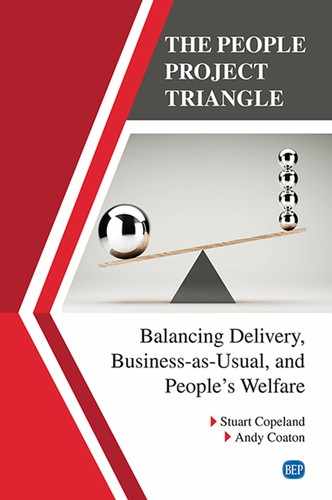Alphabets ‘f’ and ‘t’ after page numbers indicate figure and table respectively.
Association for Project Management (APM), 2
Association of Southeast Asian Nations (ASEAN), 17
business change, 21, 59, 109
drivers of, 14f
business and political ethic, 14–17
globalization, 17–18
technology, 18–19
industry concentration, 19
leaner organizations, 20
business lead, 65, 66, 75
selection, 76
business-as-usual (BaU), 9, 29, 44–45, 103
and communication, 96–97
impact on
lack of process improvements, 49–50
lost resources, 50
organizational performance, 49
organizational reputation, 52
staff performance, 50
and stakeholder-driven project manager, 81, 110
capital, 17
Competition Commission, 15
composite project, 3, 22. See also project manager
and business profit, 55–56
emotional intelligence, 81
initiation criteria, 89–92
and issues for business-as-usual staff, 44–45
issues with, 29, 30
methodology, 87–88, 111
and people project triangle, 37–39
and project initiation document, 89
and project triangle, 30, 55
recognized vs. unrecognized, 41, 52, 109
resources for, 65–66
role of team members, 75
and stakeholder-driven project manager, 81–82, 110
vision, importance of, 73, 109
vs. business-as-usual, 34–37, 46, 55
corporation, 7, 21, 59, 109
and labor, 17
need for projects, 7–8
customer matrix, 15–16
economies of scale, 15
emotional intelligence, 81
European Union, 17
London School of Economics (LSE), 20
North American Free Trade Agreement (NAFTA), 17
organization, 7. See also project triangle
composite project issue, 29, 30, 34–37, 43, 44–45
importance of reputation, 52
need for project, 7–8
project impact on reputation, 53
project vision, 73
purpose of, 7
reputation robustness, 53, 109
reputation, 52
people project triangle, 37–39, 90, 99, 107, 109
PRINCE2, 2, 9, 25
producer matrix, 16
program management, 10
project categorization, 2–3, 3f, 63
budget, 64
complexity, 63
criticality, 63–64
project communication
and business-as-usual manager, 96–97
during project launch, 97
meeting rules and criteria, 100–101
ongoing, 97
plan, 90, 111
principles, 95
report preparation, 101–102
and sponsor, 95–96, 110
and trust, 97
project initiation
clear objectives, 93
communication plan, 90, 95
estimation and forecasting, 90
kick-off workshop, 89
mini project initiation
document, 92
past project experiences, 91–92
project initiation document, 89, 97
project planning, 90–91
project scope, 90
risk assessment, 91
team and responsibilities, 90
project initiation document (PID), 89
communication goal, 97
and mini project initiation document, 92
project leadership, 95
and project sponsor, 69
reputation risks to, 41–43, 109
and stakeholder-driven project manager, 82
Project Management Institute
(PMI), 2
project management office (PMO), 23, 88
project management, 2, 23, 59, 66, 109. See also composite project; project manager
composite project initiation criteria, 89–92
day job issues, 103–104, 111–112
deliverables, 107
evolution of, 25, 26t
meeting rules and criteria, 100–101
plan management, 99–100
project methodology, 87–88
report preparation, 101–102
stakeholder-driven project manager, 81, 110
project manager, 24, 34, 65, 66
and business-as-usual manager, 96
composite vs. business-as-usual project, 34–37
day job issues, 103–104, 111–112
individual reputation, 41–43, 109
meeting rule and criteria, 100–101
method- and stakeholder
driven, 83t
method-driven, 79–80
people project triangle, 37–39
and plan management, 99–100
and project deliverables, 107
project methodology, 87–88
and project sponsor, 70, 72
and project triangle, 30
report preparation, 101–102
role of, 75, 90
selection, 76
stakeholder-driven, 80–82, 110
project resourcing
principles of communication, 95
resource advantages and disadvantages, 66
resource types, 65–66
team building, 85–86
team selection, 76–78
understanding the team, 86–87
project sponsor, 65, 66, 69, 107, 110
communication plan, 95–96
organizational qualities, 70–71
personal qualities, 71
project manager effect on, 72
role of, 69, 75
project team, 2, 65–66, 90, 110
principles of communication, 95
project methodology, 87–88, 111
role, 75, 90
selection criteria, 76–77
selection issues, 77–78
and team building, 85–86
understanding the team, 86–87, 110
project triangle, 90, 107
and composite project, 55
definition, 30
key concept, 30–31
and people project triangle, 37–39
project, 24. See also project team; project triangle
as-homework resources, cost of, 66–67
composite project issues, 29, 30
composite project risks, 41
dedicated resource, 65
definition, 9
deliverables, 9–10
features of, 9
impact on, 45, 53
initiation criteria, 89–92
methodology, 87–88, 111
program of, 10–11
vs. business-as-usual, 9, 10t, 29, 33t, 34–37, 44–45, 46
quality, 30, 31, 38, 52
scope creep, 90, 99
shareholder value, 14, 17
stakeholder management, 81
project initiation document, 89
stakeholder-driven project manager, 80–82, 110
subject matter expert (SME), 65, 66, 76
stakeholder-driven project manager, 81
super subject matter expert, 77
United Kingdom, 15
United States, 14
work-place stress, 20, 36, 38, 109
individual reputation, 41–43, 46, 109
workstream lead, 65, 66
selection, 76
and stakeholder-driven project manager, 81
workstream members, 65, 66
selection, 76–77
workstreams, 65
World Health Organization (WHO), 20
World Trade Organization (WTO), 17
Index :
Title: 24/28 pt, Goudy-Bold, U/lc, Center
Above: 7 p from Trim to top of title; Below: 3p6 b/b to text
Text: 9.5/11pt, AGaramondPro-Regular, Double Column
22 pt b/b space between index entries
